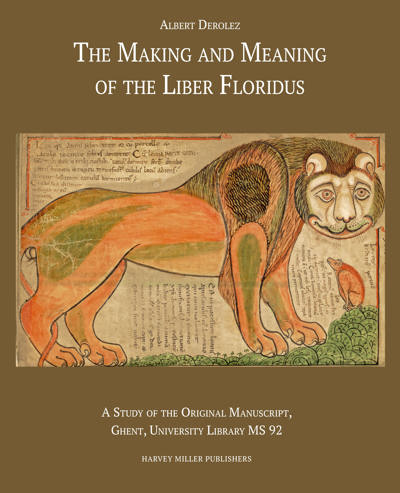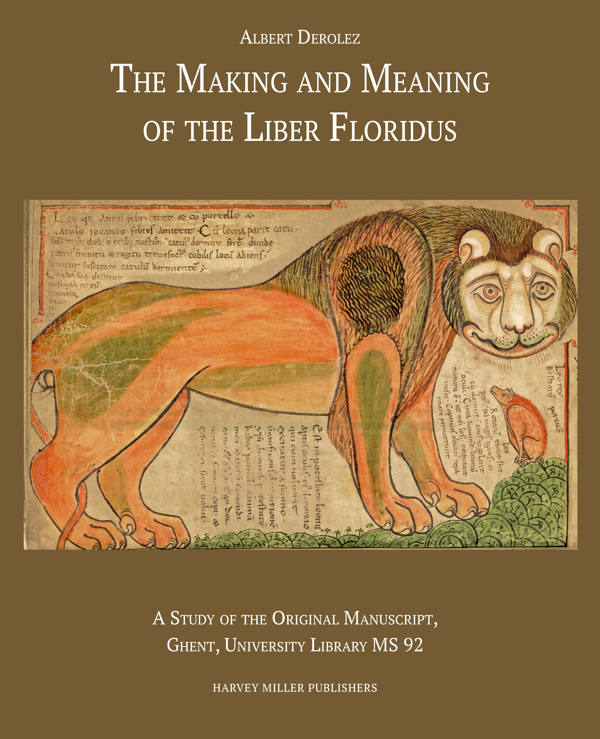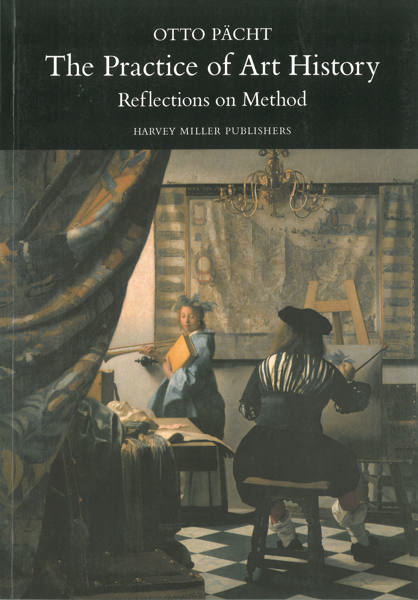
The Making and Meaning of the Liber Floridus
A Study of the Original Manuscript, Ghent, University Library, MS 92
Albert Derolez
- Pages: 355 p.
- Size:240 x 280 mm
- Illustrations:22 b/w, 98 col.
- Language(s):English
- Publication Year:2015
- € 150,00 EXCL. VAT RETAIL PRICE
- ISBN: 978-1-909400-22-1
- Hardback
- Available
“The book (...) is splendid, and Derolez deserves much praise for his elucidation of the contents and structure of the Liber Floridus, a medieval book to whose scholarship he has made important contributions throughout his career..” (Ephraim Nissan, in Philology, 2016)
“The Making and Meaning of the Liber Floridus places this fascinating codex at the figurative fingertips of scholars and students across the world. It could be a wonderful resource for teaching the history of the book or codicology at universities that lack medieval manuscripts, and this reviewer is already designing a class project around it.” (Mary Franklin- Brown, in Manuscript Studies, 2/2, 2017, p.572)
« L’immense mérite du livre d’A.D. et son dossier exhaustif des images du Liber Floridus est ainsi de nous faire sentir, au plus près des citations invoquées et de leur mise en page, les méandres d’une pensée habitée par l’attente de la fin du monde. » (Christiane Klapisch-Zuber, dans Le Moyen Âge, 123/2, 2017, p. 413)
« Le Liber Floridus reste une création exceptionnelle de l'art médiéval, tant pour la force d’expression des peintures que pour les thèmes retenus, souvent hautement inventifs. Le très riche ouvrage que Derolez vient de nous donner sera désormais l' outil premier et essentiel à utiliser pour comprendre la place qu'y prennent chacun des éléments qui le composent, texte ou illustration, et pour saisir l'histoire de leur genèse. » (Christian Heck, dans Bulletin Monumental, 175/1, 2017, p. 89)
« Si le pourquoi/pour quoi reste donc irrésolu, A. D. fournit dans cet ouvrage, illustration magistrale de ce que peut la codicologie des réponses circonstanciées, dont il est impossible de faire état dans les limites d’un compte rendu, aux questions du quoi, du comment et du quand. Il n’est plus une page peinte, plus une chapitre – virtuellement plus une ligne – du Liber Floridus qui n’ait maintenant son histoire matérielle. L’ouvrage auquel la science est redevable de ce progrès, d’une exécution typographique et graphique irréprochable, s’impose désormais comme le point de départ de tous les travaux consacres a Lambert de St-Omer et son fascinant Liber Floridus » (Antoine Brix, dans le Revue d’Histoire Ecclésiastique, 2019/1-2, p. 429)
“The reliability and clarity of this study make it the essential work on the Liber Floridus, as well as an important contribution to our understanding of medieval encyclopaedism. Added to this, its beautiful presentation, coupled with the complexity of the quires and the many quire diagrams, make it an ideal teaching tool of manuscript codicology and illumination.” (Anna Dorofeeva, in Early Medieval Europe, 28/1, 2020, p. 146)
The Liber Floridus (1121), composed, written and illustrated by Canon Lambert of Saint-Omer, is the earliest illustrated encyclopedic compilation of the Latin West. Its autograph (Ghent, University Library, MS 92), a masterpiece of Romanesque book art and one of the most complicated manuscripts ever made, has been studied by the author for almost half a century. The present book is the culmination of this research and provides a detailed codicological and textual analysis, showing how this wonderful book was put together and which are the hidden ideas Lambert sought to develop in its hundreds of texts and pictures dealing with astronomy, geography, natural history, history, religion and countless other subjects.
The book is illustrated with some 100 colour reproductions and numerous diagrams of quire structures. Three tables help the reader to understand the author’s argument, and full indices give access to the text and provide the basis for further investigation of individual chapters and pictures.




